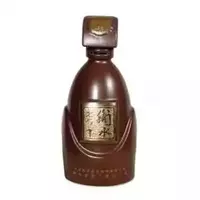Hanshin

The alcoholic beverage hanshin or hanshin is Chinese wheat vodka. Hanshin is distinguished by a cloudy color and a specific smell. For the manufacture of such a drink, as a rule, alcohol is used, which is produced from millet (gao-liana, Sorghum vulgare, Setoria Italica, Holeus Sorghum) or chumidza (panicum Italicum, panicum miliaceum) - an annual cereal plant. By the way, you can make a pretty good cereal out of it, which in its qualities is not inferior to pshen.
It is worth noting that earlier khanshin, produced in artisanal conditions, contained a very large proportion of fusel oils in its composition, which significantly worsened its taste. That is why the practice of hot hanshin was ubiquitous for old China.
To this end, the beverage was poured into a small size vessel of copper with a narrow neck. It was placed over hot coals, and after a certain time harmful volatile impurities evaporated through the neck, and the alcohol did not have time to evaporate. In addition, thanks to a narrow throat, a strong drink could not catch fire. It is worth noting that in modern production khanshin is cleaned, due to which it can be used without preheating.
There is an opinion that khanshin tastes like a rather nasty drink, so it is better to heat it before use. However, this is wrong: khanshin based on chumidza can actually differ in somewhat unattractive taste qualities, but a drink made from gao-liang does not cause any unpleasant sensations, while resembling quite a good potato or not particularly high-quality wheat vodka.
In general, as the Chinese explain, the taste properties of hanshin depend not only on the product itself, but also on the method of its purification. In addition, according to other connoisseurs and connoisseurs of this drink, it is much more profitable to drink khanshin than Russian vodka. They justify this with their own impressions: if they got drunk with hanshin today, the next day they drank water and were drunk again. Nevertheless, such a judgment is wrong - the signs of intoxication from the khanshin are similar to vodka: a little cheerfulness, denouement of the language, general excitement and, after all, sleep.
In most cases, the khanshin found on sale is somewhat stronger than ordinary Russian vodka. Judging by the feelings of the people who tasted this drink, the average strength of khanshin is 50 ° -55 °. That is why, in order not to immediately grind, khanshin is recommended to eat well and heartily, choosing meals for themselves according to taste and own preferences.
khanshina 0 kKal
Energy value of hanshin (Ratio of proteins, fats, carbohydrates - ju):
Proteins: 0 g (~ 0 kCal)
Fats: 0 g (~ 0 kCal)
Carbohydrates: 0 g (~ 0 kCal)
 Español
Español Français
Français Português
Português Русский
Русский 简体中文
简体中文 繁體中文
繁體中文 日本語
日本語 한국어
한국어 العربية
العربية Türkçe
Türkçe Қазақ
Қазақ Deutsch
Deutsch Italiano
Italiano Українська
Українська
